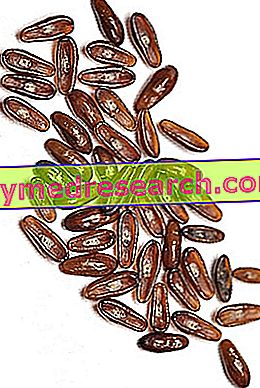The characteristic property of tannins lies in their tannin activity , that is in the ability to transform leather into leather . The tannins, in fact, inhibit the activity of proteolytic enzymes responsible for the putrefaction of animal skins. For this reason, they have been used since ancient times for leather tanning
Category pharmacognosy
MLDS: they are characterized by being all exudates; they are always heteropolysaccharides, but in fact they are called gums because of their peculiar and particular origin. Arabic gum : obtained by incision from the trunk of African trees belonging to the Leguminose family and to the genus Acacia and Acacia senegal
Medicinal plant: plant intended mainly for pharmaceutical use Medicinal plant : broader term, which serves to identify those plants that also use herbal, dietary, cosmetic and health in general. The distinction, to tell the truth, is hardly made anymore and the two terms are considered almost synonymous
Drug: plant or part of plant used after having been properly treated. First of all, it is necessary to know how to correctly collect the plant or a part of it in order to maintain the morphological and macro-microscopic characteristics reported in the Pharmacopoeia. The collection of these plants or of the parts used must be performed in an extremely specialized and technical manner, so that they remain intact
Cultivated plants are the primary source of supply, since drugs have largely a vegetable origin. Today, wild plants have been replaced by cultivated ones, essentially for market reasons. Commercial requirements have in fact imposed a quantitatively higher production than in the past. Once, wild plants were the main source of drugs and, even if the few cultivated in the past were nothing compared to the current ones, still today they play a role of enormous pharmaceutical and voluptuous importance, such as the opium poppy, coca and cannabis; all sources of drugs intended mainly for voluptuous us
Plant cultivation is not the only tool available for obtaining active principles; indeed, for some years now there have been biotechnological techniques. Biotechnologies are a tool widely used by the pharmaceutical industries, because they allow to obtain the active principles and the pharmaco-technical elements necessary for the formulation of the final product
Agar : it is used for the formulation of thickening products, capable of determining a particular consistency; it is found in volume laxative preparations and in adjuvants in low-calorie diets. Psyllium : it is a drug derived from a plant called Plantago psyllium , belonging to the Plantaginaceae family
" Pharmacognosy ": term coined in 1811 from the Greek " farmacon gnosis ", or KNOWLEDGE OF THE DRUG. The term "farmacon" has a double meaning: medicament and poison; this indicates that only a correct dosage allows us to benefit from a drug or a drug and determine its healthy appearance
Pharmacognosy deals with studying a drug , be it medicament or poison. Drugs are a means taken from the world around us, through which man can preserve and preserve health. The experience regarding the use of medicinal drugs has grown independently of populations, cultures and societies: even if with different scientific-religious connotations, we could define the vegetable source or the drug as the vehicle of health mediated by nature
The evolution of pharmacognosy takes up subjects of applied pharmaceutical botany, reflections on drugs and not on the medicinal plant. Influences of an endogenous and exogenous nature identify internal factors, which belong to the genetic heritage of the plant, factors that are part of the ontogenetic cycle of that particular species, as well as natural factors that influence the quality of the plant, but which in the end must reflect on the intended drug as its healthy expression
Shielded greenhouses: useful if drying on racks is not suitable. They are PVC or Plexiglas greenhouses of various sizes, closed, where the racks are arranged inside or the drugs are collected and hung on bunches, as in the case of tobacco. The screened greenhouse is therefore a greenhouse that has the possibility of shielding the roof, which is necessary to avoid excessive temperature rise inside the room



